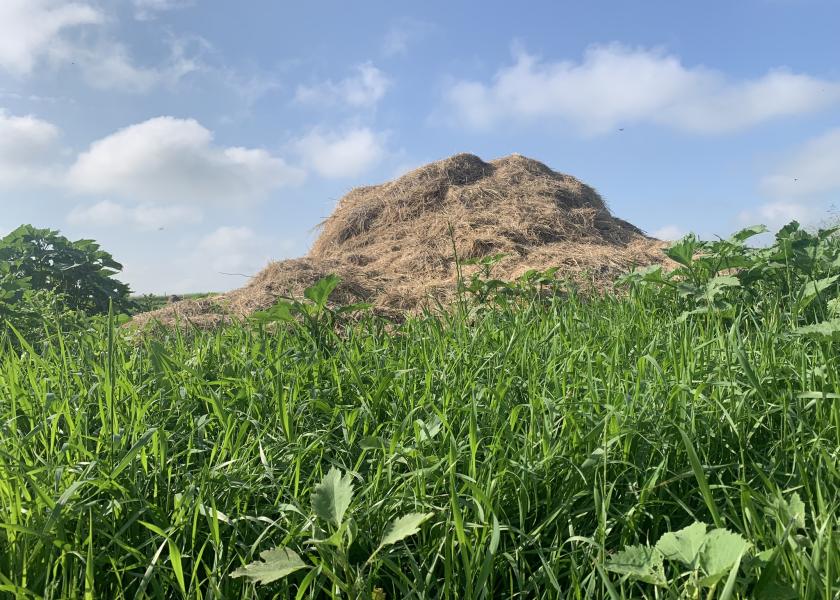Now is the Time to Manage Livestock Winter Feeding Areas

Whether farms have cattle, horses, sheep or goats, summer management of the winter feeding area is important.
“Most of the management in your winter feeding area begins with manure,” says Mary Keena, North Dakota State University Extension livestock environmental management specialist. “That is true whether your winter feeding area is corrals or a specific area of a field that you now feed on.”
While summer tasks and activities often take precedence this time of year, Keena urges ranchers to look back on what went wrong last winter and take note of what needs maintenance this summer.
“An easy place to start is pushing up manure in the winter feeding areas,” says Keena. “Making stockpiles of manure allows the pen or field surface to dry. It also allows the manure to start heating, reducing total volume and, in turn, reducing total loads hauled when removed.”
Composting livestock manure will increase the volume reduction compared to stockpiling, as well as reduce internal and external parasites, pathogens and weed seeds. To compost manure, turn the piles every 10-14 days while maintaining 50% moisture. Learn more about composting in the NDSU Extension publication, “Composting Animal Manures,” available at ndsu.ag/manures.
When animals are still present in winter feedings areas, fly control via manure management is also important. Flies lay their eggs in the top few inches of manure, and the eggs can hatch every seven days. By pushing the manure into a pile and turning the piles, you can compost manure and stay ahead of the fly cycle.
Often the nutrients from manure can help fertilize undesirable weeds in your feeding areas. If the weeds have already gotten away from you, several management strategies can help reduce weed population and spread.
“Repeated mowing reduces weeds' competitive ability, depletes carbohydrate reserves in their roots, and reduces seed production,” says Penny Nester, NDSU Extension agent in Bowman County. “Mowing can kill or suppress annual and biennial weeds. It also can suppress perennials and help restrict their spread.”
A single mowing will not satisfactorily control most weeds. However, mowing three or four times per year over several years can greatly reduce and occasionally eliminate certain weeds. Mowing along fences and borders can help prevent the introduction of new weed seeds. Regular mowing helps prevent weeds from establishing, spreading and competing with desirable grasses and legumes.
Another option for weed control is to apply herbicides, says Nester. It is best to apply herbicides to weeds that are still young because they will absorb the chemicals more effectively than their mature counterparts. Herbicide can also be effective to treat actively growing weeds in the weeks following mowing.
Ideal temperatures for applying most herbicides are between 65 and 85 degrees Fahrenheit. Avoid applying volatile herbicides such as 2,4-D ester, MCPA ester and dicamba during hot weather, especially near susceptible broadleaf crops, shelterbelts or farmsteads.
Cleaning pen and field surfaces is a great time for reflection of the past season. What worked? What didn’t? What should be fixed, changed or maintained now to make the next winter feeding season successful?
Keena and Nester offer some considerations for maintenance:
- Notice and manage stress. The “winter” season started in October 2022 for some animal owners and lasted through May 2023. While commiserating with family and friends will sometimes help, consider exploring NDSU Extension’s “Coping with Stress” resources available at ag/copingwithstress. Sometimes we need the help, and sometimes we are the help. Either way, a refresher is good practice.
- How do the fences look? Are there any places that need fixing?
- Did the watering system work during the winter feeding period? What changes or fixes can help prevent leaking or freeze-ups?
- How level are pen surfaces? Are there holes to be filled? Are any areas holding water? Gravel and clay are commonly used to backfill these areas and regain proper slope and drainage in the pen.
If you are experiencing challenges in your livestock winter feeding areas or need a list of for-hire custom manure applicators in your county, contact your county NDSU Extension agent for resources and help. Visit www.ndsu.edu/agriculture/ag-home/directory to find their contact information.







